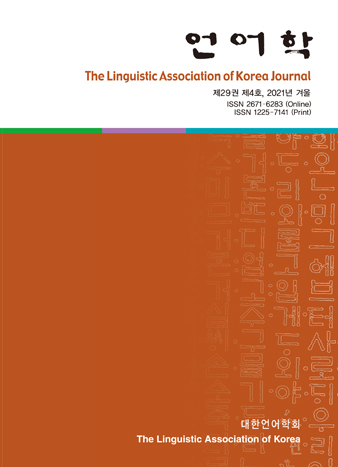대한언어학회 전자저널
29권 4호 (2021년 12월)
- 한국어 주격표지, 격표지의 생략, 초점, 그리고 화제
-
이종근
Pages : 21-43
Abstract
Lee, Jong Kun. (2021). Nominative case markers, ellipsis of case markers, focus, and topic in Korean. The Linguistic Association of Korea Journal, 29(4), 21-43. The purpose of this paper is to investigate how various morphemes are used to indicate topics in Korean. While in many cases, the so-called nominative case marker i/-ka occurs to indicate focus in Korean, this study claims that these so-called nominative case markers can be also used as a special form of topic markers in Korean and offers various data to support this claim. In addition, this paper discusses how bare nominal phrases can occur to indicate topics in place of nominal phrases marked with the topic marker un/-nun. This study further argues that, in principle, to indicate topics in Korean, the topic marker un/-nun occurs when there is a contextually relevant alternative comparable with the topic while the so-called nominative marker i/-ka occurs when there is no relevant alternative in terms of the situation-internal point of view. This paper also gives evidence that, contrary to the claims made by Lambrecht and Michaelis (1998) and Oh (2009), nominative case-marked noun phrases in Korean can indicate ratified as well as unratified topics.
Keywords
# 화제(topic) # 화제표지(topic marker) # 초점(focus) # 격표지(case marker) # 주격표지(nominative case marker) # 인준된 화제(ratified topic)
References
- 박정섭. (1992). 중주어와 중목적어. 생성문법연구, 2(2), 293-334.
- 이종근. (2018). 한국어 격표지의 본질과 초점. 언어연구, 33(4), 733-755.
- 이종근. (2019). 한국어 주격 표지 ‘-이/가’와 화제의 표시. 언어연구, 34(4), 593-605.
- 최기용. (2009). 한국어 격과 조사의 생성통사론. 서울: 한국문화사.
- 홍기선. (2007). 한국어의 조사 ‘가’. Comparative Korean Studies, 15(2), 23-46.
- 홍기선. (2017). 한국어의 조사 ‘가’와 ‘를’: 격과 의미. 언어, 42(4), 961-988.
- Brentano, F. (1973). Psychology from an empirical standpoint. Translated by Antos C. Rancurello, D. B. Terrell, and Linda L. McAlister from Psychologie vom empirschen Standfunkt (1874, 1924). Sections V-IX.
- Chafe, W. L. (1976). Givenness, contrastiveness, definiteness, subjects, topics and point of view. In C. Li (Ed.), Subject and topic (pp. 25-56). New York: Academic Press.
- Enç, M. (1991). The semantics of specificity. Linguistic Inquiry, 22(1), 1-25.
- Gundel, J. (1974). The role of topic and comment in linguistic theory. Unpublished doctoral dissertation, University of Texas.
- Gundel, J. (1988). Universals of topic-comment structure. In Hammond et al (Eds.), Studies in syntactic typology (pp. 209-239). Amsterdam: John Benjamins.
- Gussenhoven, C. (2008). Types of focus in English. In C. Lee, M. Gordon, & D. Buring (Eds.), Topic and focus: Cross-linguistics perspectives on meaning and intonation. Dordrecht: Springer.
- Hawkins, J. A. (1978). Definiteness and indefiniteness: A study in reference and grammaticality prediction. London: Croom Helm.
- Hockett, C. F. (1958). A course in modern linguistics. New York: Macmillan.
- Hong, K.-S. (1990). Subject-to-object raising in Korean. In Dziwirek et al (Eds.), Grammatical relations: a cross-theoretical perspective (pp. 215-225). Stanford: CSLI.
- Hong, K.-S. (1991). Argument selection and case marking in Korean. Unpublished doctoral dissertation, Stanford University.
- Kim, I.-K. (2015). Is Korean -(n)un a topic marker? On the nature of -(n)un and its relation to information structure. Lingua, 154, 87-109.
- Kim, M.-J. (2021). Anaphoric definiteness marking in Korean and the role of point of view. Paper presented at the 2021 KGGC and KSLI Conference, on-line, 6 November.
- Krifka, M. (2007). Basic notions of information structure. In C. Féry, G. Fanselow, & M. Krifka (Eds.), The notions of information structure: Interdisciplinary studies on information structure, Vol. 6, 13-55.
- Kuroda, S.-Y. (1972). The categorical and the thetic judgment. Foundations of Language, 9, 153-185.
- Lambrecht, K. (1994). Information structure and sentence form: Topic, focus, and the mental representation of discourse referents. Cambridge: Cambridge University Press.
- Lambrecht, K. and Michaelis, L. A. (1998). Sentence accent in information questions: default and projection. Linguistics and Philosophy, 21(5), 477-544.
- Lambrecht, K. (2000). When subjects behave like objects: an analysis of the merging of S and O in sentence-focus constructions across languages. Studies in Language, 24(3), 611-682.
- Lee, Y.-S. (1990). Is INFL universal? A case study of Korean. In Y.-K. No & M. Libucha (Eds.), ESCOL’90: Proceedings of the Seventh Eastern Conference on Linguistics, 204-214.
- MacDonald, D., & Welch, N. (2009). Topic, focus and double subjects in Korean. Proceedings of the 2009 annual conference of the Canadian Linguistic Association, 1-14.
- Nakipoglu, M. (2009). The semantics of the Turkish accusative marked definites and the relation between prosodic structure and information structure. Lingua, 119(9), 1253-1280.
- Oh, C.-S. (2008). Ratified and unratified topics in spoken Korean. 언어학, 16(3), 25-41.
- Oh, C.-S. (2009). -Un/nun as an unratified topic marker in Korean. 언어, 34(3), 603-624.
- Park, D.-W. (2010). Some notes on multiple nominative constructions in Korean. SNU Working Papers in English Language and Linguistics, 9, 36-65.
- Portner, P. (2007). Instructions for interpretation as separate performatives. In K. Schwabe & S. Winkler (Eds.), On information structure, meaning and form (pp. 407-426). Amsterdam: John Benjamins.
- Reinhart, T. (1981). Pragmatics and linguistics: An analysis of sentence topics. Philosophica, 27(1), 53-94.
- Rizzi, L. (2004). The structure of CP and IP: The cartography of syntactic structures. Oxford: Oxford University Press.
- Rooth, M. (1985). Association with focus. Unpublished doctoral dissertation, University of Massachusetts, Amherst.
- Schütze, C. T. (1996). Korean "case stacking" isn't. Unifying non-case uses of case particles. In K. Kusumoto (Ed.), Proceedings of NELS 26, 351-365. Amherst, Massachusetts.
- Schütze, C. T. (2001). On Korean ‘case stacking': The varied functions of the particles ka and lul. The Linguistic Review, 18, 193-232.
- Strawson, P. F. (1964). Identifying reference and truth values. Theoria, 30, 96-118. Vallduvi, E. (1990). The informational component. Unpublished doctoral dissertation, University of Pennsylvania.
